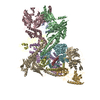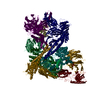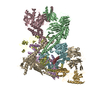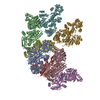+ Open data
Open data
- Basic information
Basic information
| Entry | Database: PDB / ID: 6voa | ||||||
|---|---|---|---|---|---|---|---|
| Title | Cryo-EM structure of the BBSome-ARL6 complex | ||||||
 Components Components |
| ||||||
 Keywords Keywords | PROTEIN TRANSPORT / Cilia / Bardet-Biedl Syndrome | ||||||
| Function / homology |  Function and homology information Function and homology informationBBSome binding / establishment of anatomical structure orientation / BBSome-mediated cargo-targeting to cilium / multi-ciliated epithelial cell differentiation / receptor localization to non-motile cilium / renal tubule development / BBSome / camera-type eye photoreceptor cell differentiation / smoothened binding / establishment of planar polarity ...BBSome binding / establishment of anatomical structure orientation / BBSome-mediated cargo-targeting to cilium / multi-ciliated epithelial cell differentiation / receptor localization to non-motile cilium / renal tubule development / BBSome / camera-type eye photoreceptor cell differentiation / smoothened binding / establishment of planar polarity / photoreceptor connecting cilium / axonemal microtubule / inner ear receptor cell stereocilium organization / patched binding / olfactory bulb development / membrane coat / non-motile cilium assembly / phosphatidylinositol-3-phosphate binding / establishment of epithelial cell apical/basal polarity / protein localization to cilium / regulation of stress fiber assembly / non-motile cilium / motile cilium / protein targeting to membrane / centrosome cycle / ciliary membrane / pericentriolar material / fat cell differentiation / axoneme / centriolar satellite / protein polymerization / cilium assembly / intracellular transport / vesicle-mediated transport / ciliary basal body / protein localization to plasma membrane / axon guidance / intracellular protein transport / protein localization / multicellular organism growth / phospholipid binding / cilium / regulation of protein localization / sensory perception of smell / protein transport / protein-macromolecule adaptor activity / RNA polymerase II-specific DNA-binding transcription factor binding / neuron projection / GTPase activity / centrosome / GTP binding / membrane / cytoplasm Similarity search - Function | ||||||
| Biological species |  | ||||||
| Method | ELECTRON MICROSCOPY / single particle reconstruction / cryo EM / Resolution: 4 Å | ||||||
 Authors Authors | Yang, S. / Walz, T. / Nachury, M.V. | ||||||
| Funding support |  United States, 1items United States, 1items
| ||||||
 Citation Citation |  Journal: Elife / Year: 2020 Journal: Elife / Year: 2020Title: Near-atomic structures of the BBSome reveal the basis for BBSome activation and binding to GPCR cargoes. Authors: Shuang Yang / Kriti Bahl / Hui-Ting Chou / Jonathan Woodsmith / Ulrich Stelzl / Thomas Walz / Maxence V Nachury /   Abstract: Dynamic trafficking of G protein-coupled receptors (GPCRs) out of cilia is mediated by the BBSome. In concert with its membrane recruitment factor, the small GTPase ARL6/BBS3, the BBSome ferries ...Dynamic trafficking of G protein-coupled receptors (GPCRs) out of cilia is mediated by the BBSome. In concert with its membrane recruitment factor, the small GTPase ARL6/BBS3, the BBSome ferries GPCRs across the transition zone, a diffusion barrier at the base of cilia. Here, we present the near-atomic structures of the BBSome by itself and in complex with ARL6, and we describe the changes in BBSome conformation induced by ARL6 binding. Modeling the interactions of the BBSome with membranes and the GPCR Smoothened (SMO) reveals that SMO, and likely also other GPCR cargoes, must release their amphipathic helix 8 from the membrane to be recognized by the BBSome. | ||||||
| History |
|
- Structure visualization
Structure visualization
| Movie |
 Movie viewer Movie viewer |
|---|---|
| Structure viewer | Molecule:  Molmil Molmil Jmol/JSmol Jmol/JSmol |
- Downloads & links
Downloads & links
- Download
Download
| PDBx/mmCIF format |  6voa.cif.gz 6voa.cif.gz | 648 KB | Display |  PDBx/mmCIF format PDBx/mmCIF format |
|---|---|---|---|---|
| PDB format |  pdb6voa.ent.gz pdb6voa.ent.gz | 496.4 KB | Display |  PDB format PDB format |
| PDBx/mmJSON format |  6voa.json.gz 6voa.json.gz | Tree view |  PDBx/mmJSON format PDBx/mmJSON format | |
| Others |  Other downloads Other downloads |
-Validation report
| Summary document |  6voa_validation.pdf.gz 6voa_validation.pdf.gz | 1011.1 KB | Display |  wwPDB validaton report wwPDB validaton report |
|---|---|---|---|---|
| Full document |  6voa_full_validation.pdf.gz 6voa_full_validation.pdf.gz | 1 MB | Display | |
| Data in XML |  6voa_validation.xml.gz 6voa_validation.xml.gz | 100.6 KB | Display | |
| Data in CIF |  6voa_validation.cif.gz 6voa_validation.cif.gz | 156 KB | Display | |
| Arichive directory |  https://data.pdbj.org/pub/pdb/validation_reports/vo/6voa https://data.pdbj.org/pub/pdb/validation_reports/vo/6voa ftp://data.pdbj.org/pub/pdb/validation_reports/vo/6voa ftp://data.pdbj.org/pub/pdb/validation_reports/vo/6voa | HTTPS FTP |
-Related structure data
| Related structure data |  21259MC  6vnwC M: map data used to model this data C: citing same article ( |
|---|---|
| Similar structure data |
- Links
Links
- Assembly
Assembly
| Deposited unit | 
|
|---|---|
| 1 |
|
- Components
Components
-Bardet-Biedl syndrome ... , 6 types, 6 molecules HBEGCI
| #1: Protein | Mass: 8070.502 Da / Num. of mol.: 1 / Source method: isolated from a natural source / Source: (natural)  |
|---|---|
| #2: Protein | Mass: 79911.484 Da / Num. of mol.: 1 / Source method: isolated from a natural source / Source: (natural)  |
| #3: Protein | Mass: 58289.133 Da / Num. of mol.: 1 / Source method: isolated from a natural source / Source: (natural)  |
| #4: Protein | Mass: 38880.984 Da / Num. of mol.: 1 / Source method: isolated from a natural source / Source: (natural)  |
| #5: Protein | Mass: 80471.375 Da / Num. of mol.: 1 / Source method: isolated from a natural source / Source: (natural)  |
| #7: Protein | Mass: 99230.914 Da / Num. of mol.: 1 / Source method: isolated from a natural source / Source: (natural)  |
-Protein , 3 types, 3 molecules FAD
| #6: Protein | Mass: 56686.406 Da / Num. of mol.: 1 / Source method: isolated from a natural source / Source: (natural)  |
|---|---|
| #8: Protein | Mass: 21086.486 Da / Num. of mol.: 1 Source method: isolated from a genetically manipulated source Source: (gene. exp.)   |
| #9: Protein | Mass: 64939.141 Da / Num. of mol.: 1 / Source method: isolated from a natural source / Source: (natural)  |
-Experimental details
-Experiment
| Experiment | Method: ELECTRON MICROSCOPY |
|---|---|
| EM experiment | Aggregation state: PARTICLE / 3D reconstruction method: single particle reconstruction |
- Sample preparation
Sample preparation
| Component |
| ||||||||||||||||||||||||
|---|---|---|---|---|---|---|---|---|---|---|---|---|---|---|---|---|---|---|---|---|---|---|---|---|---|
| Source (natural) |
| ||||||||||||||||||||||||
| Source (recombinant) | Organism:  | ||||||||||||||||||||||||
| Buffer solution | pH: 7.5 | ||||||||||||||||||||||||
| Specimen | Embedding applied: NO / Shadowing applied: NO / Staining applied: NO / Vitrification applied: YES | ||||||||||||||||||||||||
| Vitrification | Instrument: FEI VITROBOT MARK IV / Cryogen name: ETHANE / Humidity: 100 % / Chamber temperature: 277 K |
- Electron microscopy imaging
Electron microscopy imaging
| Experimental equipment |  Model: Titan Krios / Image courtesy: FEI Company | ||||||||||||
|---|---|---|---|---|---|---|---|---|---|---|---|---|---|
| Microscopy | Model: FEI TITAN KRIOS | ||||||||||||
| Electron gun | Electron source:  FIELD EMISSION GUN / Accelerating voltage: 300 kV / Illumination mode: FLOOD BEAM FIELD EMISSION GUN / Accelerating voltage: 300 kV / Illumination mode: FLOOD BEAM | ||||||||||||
| Electron lens | Mode: BRIGHT FIELD | ||||||||||||
| Image recording |
|
- Processing
Processing
| Image processing | Details: For final refinement, particles were combined from data of both K2 and K3 detector. |
|---|---|
| CTF correction | Type: PHASE FLIPPING AND AMPLITUDE CORRECTION |
| 3D reconstruction | Resolution: 4 Å / Resolution method: FSC 0.143 CUT-OFF / Num. of particles: 546186 / Symmetry type: POINT |
 Movie
Movie Controller
Controller











 PDBj
PDBj


